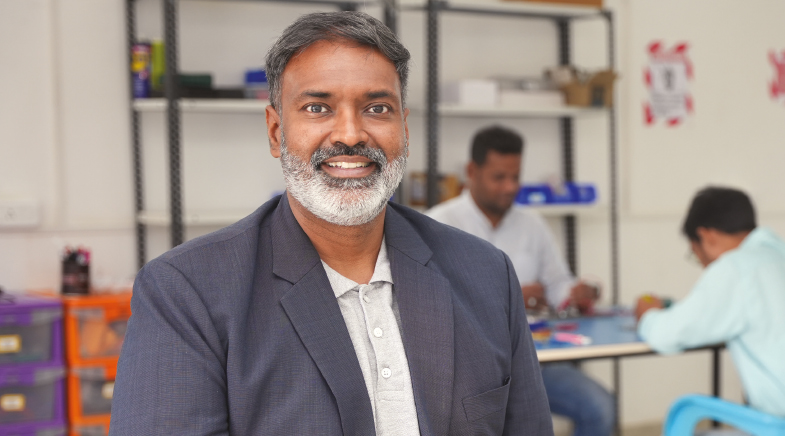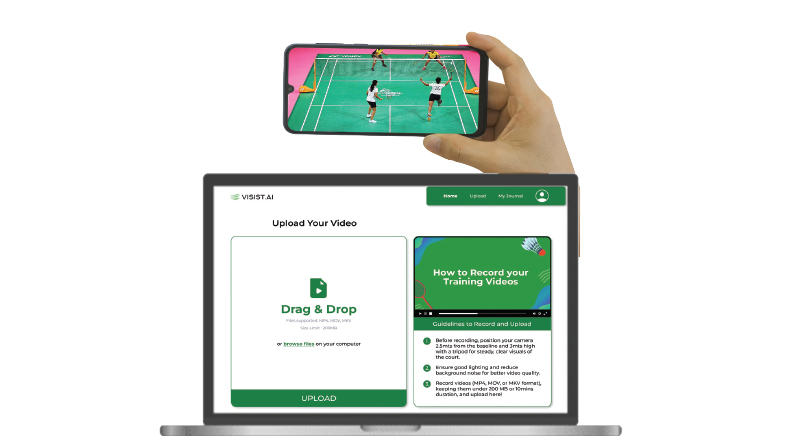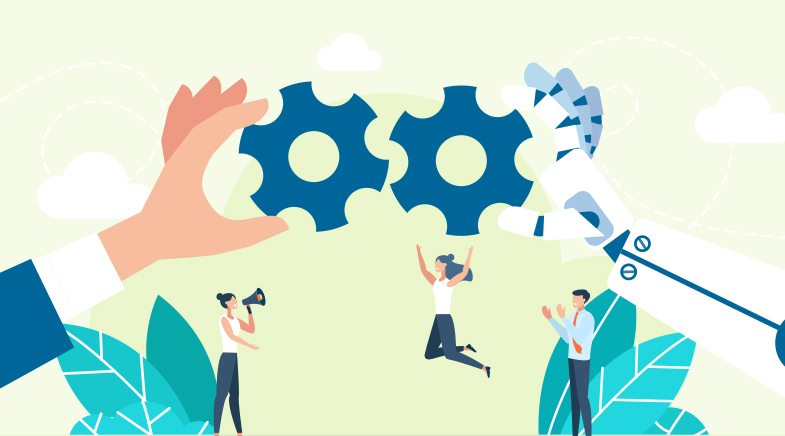How AI keeps our roads safe
-
- from Shaastra :: vol 02 issue 05 :: Sep - Oct 2023

Researchers are leveraging AI and data science to make Indian roads safer.
Chartered accountant Vanesh Naidoo had lived and worked abroad for several years before moving to India. The relocation, however, wasn't smooth. Driving, for instance, was a major headache. Intimidated by the general disregard for traffic rules on Indian roads, he decided to install a dashboard camera in his car that would capture video or photographic evidence if there was a road accident.
Naidoo had reason to be worried. According to a 2021 World Bank report, India, with just 1% of the world's vehicles, accounts for 11% of global road accident deaths. Among the major reasons for road accidents in India in 2021 were speeding, distraction, and a driver's error of judgement regarding turns, says a 2022 report of the Ministry of Road Transport and Highways.
"About 1.5 lakh people die due to road accidents every year, which is almost like COVID happening every year," says Akhilesh Kumar Maurya, Professor at the Indian Institute of Technology (IIT) Guwahati, and a certified 'Road Safety Auditor'.
In 2015, India became a signatory to the Brasilia Declaration and pledged to halve road accident deaths by 2020. Though it couldn't meet the target and deferred the deadline to 2030, the commitment spurred road and traffic research in the country. Academicians, companies, government and start-ups are today working, often together, to achieve this goal by 2025.
Digital technologies such as data science, artificial intelligence (AI), and image processing play a pivotal role in what's known as the four 'E's of road safety: education, engineering, enforcement and emergency care. The availability of affordable smartphones with cameras and GPS, along with 4G connectivity, has helped to collect and analyse data from the roads. Computer vision technology enables drivers to steer carefully. It helps law agencies penalise offenders, manage vehicular flows, and audit road infrastructure to achieve Vision Zero — a global movement to end traffic-related deaths and injuries.
DRIVER ASSIST SYSTEMS
The movement towards road safety — and the fact that Naidoo couldn't find a good enough dash camera in India — prompted him to set up a company called Safe Cams in Pune in 2018. Besides a front-facing dash camera that records movements on the road, the company provides car monitoring solutions. One of its products is a driver-facing, AI camera that is GPS- and 4G-enabled. The camera, fitted to a vehicle, may help companies assess drivers' behaviour and determine if they are looking at the road, using a mobile phone, or feeling sleepy. The AI algorithm for this was trained on South Indian faces.
Safe Cams, started up by Vanesh Naidoo (top), provides car monitoring solutions that use AI algorithms, GPS and gyroscope sensors to enhance road safety.
Another of its products detects speeding, harsh acceleration, braking, and sharp turns by using an advanced AI algorithm that processes data obtained from precise G-sensors (which can detect and record changes in acceleration and collisions/impacts on vehicle), GPS and gyroscope sensors. The company also provides an Advanced Driver Assistance System (ADAS) that warns drivers about lane departures and possible collisions.
While ADAS is common in the luxury car segment, the government plans to mandate it in all cars. This has pushed companies to develop new systems. While the earlier RADAR-based ADAS was expensive, the new ones use computer vision technology and may be cheaper.
BRAKE ON SPEEDING
Around 70% of road accidents in India occur because of speeding. Very often, drivers have an accident when they are unable to judge the appropriate speeds that can help them turn at a particular junction. The government has mandated that cars have speed governor systems, which warn a driver if the vehicle crosses a specified speed limit.

Maurya, however, believes that speed warning systems should be based on a road's infrastructure, geometry and geography — and not follow a "one-size-fits-all approach". Towards this, his team, with IIT Bombay researchers, has developed a smart speed warning system by collecting GPS and speed data from a 45-km stretch between Jorhat in Assam and Nongpoh in Meghalaya, which has 285 curves. This data was used to train an AI algorithm to predict the safe speed for a vehicle at specific bends. This AI-based speed warning system alerts the driver about safe speeds approaching sharp curves, and thus prevents accidents. The team is validating the algorithm over a larger dataset and is in the process of patenting it.
Maurya has another proposal: rewards for a good driver and penalties for an erratic one. He believes there should be a driving score, like a CIBIL Score. A good score can help fetch car loans and insurance at a lower cost. The driving score can be based on data collected on ADAS or an app installed on a mobile that will gather data related to steering, lane changes, speeding, sharp turns, and so on.
TRAFFIC AND ROAD AUDITS
Autonomous vehicles are still a distant dream in India. Still, C.V. Jawahar, Professor at the International Institute of Information Technology (IIIT) Hyderabad, believes there is merit in understanding why it is hard to deploy self-driving vehicles in India. "Answering the question of why autonomous driving is hard in India will indirectly throw light on why accidents happen in India," Jawahar says.
Data science, AI and image processing play a pivotal role in the four 'E's of road safety: education, engineering, enforcement and emergency care.
While exploring the application of machine learning and computer vision in autonomous driving, Jawahar found that the lack of road data in India hindered his research. As Indian traffic and road conditions differ vastly from those in other countries, international datasets could not be used to resolve Indian traffic problems. So, together with Intel, he built an Indian Driving Dataset (IDD) in 2016. The IDD consists of 10,000 images obtained from a front-facing camera attached to a car. These images were captured when the vehicle was driven around Hyderabad, Bengaluru and their outskirts. The dataset is now available in the public domain (bit.ly/IDD-dataset) for analysis.
Using this, Jawahar has developed an AI algorithm that can detect violations such as motorcyclists riding without helmets or when there are more than two people on a two-wheeler. The algorithm uses videos recorded from cameras on vehicles.
Jawahar proposes a cost-effective solution to curb traffic violations and thereby improve a driver's road sense. Currently, such violations are either caught by the traffic police or through surveillance cameras. These cameras, however, are static. Jawahar proposes that cameras be mounted on public vehicles, such as buses and police vehicles.
"People usually change their driving behaviour when they are close to static traffic cameras. But cameras that are not on a fixed spot and could be anywhere will force people to change their driving behaviour (for good)," he says.
WARNING SIGNS
Apart from road sense, several other factors can curb road accidents. These include appropriate traffic and warning signs at specific junctions. Jawahar's team has trained an algorithm to identify regions where a signboard would help a driver. Manually identifying regions with missing traffic signs is a tedious job; an automated solution can help authorities plan infrastructure improvements.
Researchers are also focusing on two-wheelers, which dominate Indian roads. The heterogeneity of vehicles on Indian roads is why Western road and traffic research and solutions cannot be extrapolated to manage Indian roads and traffic. Researchers have therefore developed Indian traffic datasets and models of traffic for AI applications.
Many Indian cities such as Bengaluru, Delhi and Thiruvananthapuram, as well as parts of Goa, use AI-powered static traffic cameras to monitor violations. An AI-powered Integrated Traffic Management System (ITMS) is being planned for Delhi that will synchronise all traffic signals to regulate vehicular movement at different junctions. This will also help in the quick movement of emergency vehicles such as ambulances, fire brigades and police vans.
Similarly, a consortium project named iRASTE (Intelligent Solutions for Road Safety through Technology and Engineering) is being implemented in Nagpur and parts of Telangana. It uses AI to identify accident-prone areas and chalk out action needed to prevent accidents in those areas.
Start-ups are also contributing to making Indian roads safe. Bengaluru-based RoadMetrics uses AI to identify road defects and informs private infrastructure and municipal corporations about them. Mumbai-based Accelo Innovation has a product that uses computer vision technology to send pre-collision alerts to drivers.
Taken together, digital technologies are making Indian roads safer. Naidoo may soon be able to navigate Indian roads with ease.
Have a
story idea?
Tell us.
Do you have a recent research paper or an idea for a science/technology-themed article that you'd like to tell us about?
GET IN TOUCH














